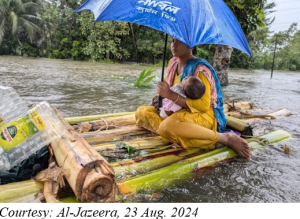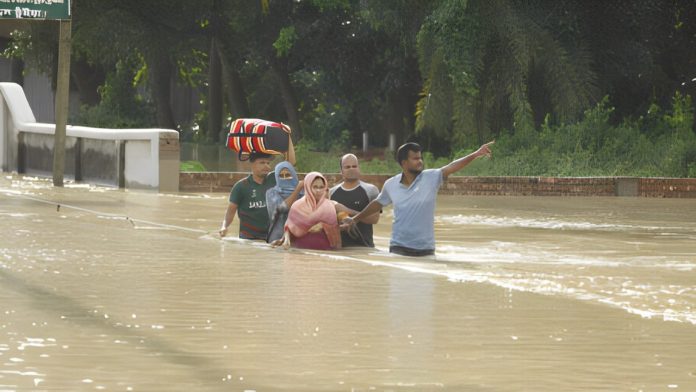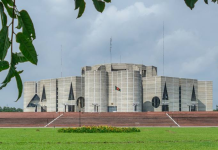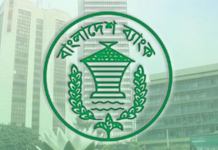People in the Burichang area of Cumilla district, evacuating their homes for higher grounds as floodwaters rise. The devastating flood has affected millions of lives across 11 districts and displaced people across southeastern Bangladesh, compelling them to seek shelter on higher ground. Photo: TBS
Over 18 million people in Bangladesh have been affected, with more than 1.2 million families trapped as flash floods submerge vast areas of the country’s east and southeast, according to the United Nations. The UN also reported massive damages to roads, croplands, and fisheries, severely impacting livelihoods.
 Many have accused that the floods were caused by India’s deliberate opening of the Dumbur Dam, which is upstream of the Gumti River in India’s Tripura State. Officials at Bangladesh’s Flood Forecasting and Warning Centre Al-Jazeera that unlike in the past, India did not issue a warning to its neighbour on the release of water. That warning could have helped prevent deaths and destruction.
Many have accused that the floods were caused by India’s deliberate opening of the Dumbur Dam, which is upstream of the Gumti River in India’s Tripura State. Officials at Bangladesh’s Flood Forecasting and Warning Centre Al-Jazeera that unlike in the past, India did not issue a warning to its neighbour on the release of water. That warning could have helped prevent deaths and destruction.
India’s think tank, SANDRP (South Asia Network on Dams, Rivers and People), said the flood would have been less severe had the release of water from the reservoir above Tripura’s Dumbur dam started at least two days before the water level crossed the danger level. Thus, SANDRP has raised the question of negligence or human error.
Moreover, it was not possible to transmit flood warning messages for two days due to the lack of electricity in the water measuring station located downstream of the dam due to the flood. That means, Bangladesh did not receive the warning on time.
India’s denial
Predictably, India denied the accusation saying that the flooding was from excessive rain and water from large catchments downstream of the dam. India’s high commissioner to Bangladesh, told Professor Yunus, the Head of the Interim Government that the water from the dam was “released automatically” due to elevated levels.
 India said the opening of gates of Dumbur Dam cannot be only blamed for severe floods, which was also caused by heavy rains. Regarding the Ganges, they said opening the gates of the Farakka Barrage and releasing the flood water caused by heavy rain upstream into the Ganga/Padma River is a normal development during the wet seasons.
India said the opening of gates of Dumbur Dam cannot be only blamed for severe floods, which was also caused by heavy rains. Regarding the Ganges, they said opening the gates of the Farakka Barrage and releasing the flood water caused by heavy rain upstream into the Ganga/Padma River is a normal development during the wet seasons.
There are 54 transboundary rivers between India and Bangladesh. India’s Foreign Ministry said, “We remain committed to resolving issues and mutual concerns in water resources and river water management through bilateral consultations and technical discussions.”
The International Farakka Committee (IFC) issued a statement on 14 July 2024 when a large area of South East, East North, East and North of Bangladesh was inundated by floodwaters due to the sudden opening of sluice gates of ‘Dumber Barrage’ situated on the upper part of the Gumuti River, as well as, all the sluice gates of Farakka Barrage by India.
In a joint statement of IFC-NY and IFC-Dhaka Chapter, the IFC leaders observed, that the Ministry of External Affairs of India has given an explanatory reply (this time), after many days to the allegations of the unusual floods in the Gumti River and also the opening of all the sluice gates of the Farakka Barrage.
Transboundary rivers of Bangladesh
Bangladesh is a riverine country. The Padma (Ganges), Meghna, Jamuna (Brahmaputra), Karnaphuli, Surma, Teesta, Barak and innumerable large, medium and small rivers, tributaries and distributaries criss-cross the country. Out of 57 trans-boundary rivers flowing through India and Bangladesh, 54 of them originate in the Himalayan region and other parts of India.
Rainwater in Bangladesh accounts for only 7% of the total fresh water flow; the remaining 93% comes from trans-boundary river sources fed by rain and melting-ice. At the global scale, freshwater of lakes and rivers, which are the main sources for water consumed by human societies, contain on an average about 90,000 Billion Cubic Meters (BCM) of water, accounting for about 26% of total global freshwater reserves. The Himalayan region contains about 25% of the global fresh water.
Despite continuous assurances from India, the Bangladesh part of the river continues to be deprived of water in the dry season. At the upstream, the flow has been diverted and channelled to the Ganges by constructing at least three more upstream barrages. As time passes, the possibility of Bangladesh’s due share of the river’s flow looks more and more remote.
Water treaty / agreement on the Ganges
Of the 54 shared rivers that flow through Bangladesh and India, there is an agreement/ treaty only on the Ganges. However, that too on the basis of an outdated notion of water sharing at the border. The agreement will expire in 2026.
The two countries have been talking about an agreement on the Teesta for the past 13 years. But practically nothing happens. The situation is such that Bangladesh has to take flood water in monsoon, but it has no right to water-sharing in dry seasons. “International law does not support this”, emphasizes the IFC.
From 2000, India is implementing the ‘Inter-basin River Linking Project’ to divert water from all trans-boundary common rivers]. This is an on-going mega engineering project that aims to manage water resources in India by linking common rivers of India and Bangladesh rivers by a network of reservoirs and canals to enhance irrigation and ground water recharge, reduce persistent floods in some part of India and water shortage in other parts of India.
Farakka Barrage and India’s non-compliance
India constructed a barrage at Farakka on the upstream of the Ganges and started withdrawal of water on the basis of an ad-hoc agreement signed on 18 April, 1975. In this agreement Bangladesh gave consent for withdrawal of 11-16 thousand cusec water from April 21 to May 31, for a limited period of 41 days. In return India promised that rest of the water would flow through Bangladesh.
However, after the expiry of the agreed 41 days periods, India, kept on withdrawing water in the lean periods of 1975 and 1976. In April 1976, the flow of water from the Ganges at the Hardinge Bridge point, came to as low as 23 thousand cusec against 65 thousand cusec of the corresponding period of the previous year.
India signed, a 5-year, water-sharing Treaty with Bangladesh on 5 November 1977 during President Ziaur Rahman’s regime. The Treaty had a Guarantee Clause for 80% of the flow to Bangladesh during the lean period and an Arbitration clause. After the expiry of the Treaty in 1982, India refused to renew the treaty or extend its duration.
Then in October 1982, a two-year mutual agreement, followed by another 3-year agreement (on Nov. 22, 1985) was signed between the two countries. However, in both agreements, the Guarantee and Arbitration clause of 1977 Treaty were absent. After that, on 12 December 1996, a 30-year Water Treaty was signed between India and Bangladesh. This Treaty was also devoid of the Guarantee and Arbitration clauses. After the 1996 Treaty, during the lean period, thpe flow of water at the Hardinge Bridge point goes down to 10 thousand cusec, and even sometimes as low as 5 thousand cusec.
During the lean period of 2019, Bangladesh sent a letter to the Joint River Commission complaining that Bangladesh is not getting her due share of water according to the Farakka Treaty of 1996. This was the first time Bangladesh had officially informed India about non-compliance of the Treaty. The International Farakka Committee (IFC) Bangladesh organized an Opinion Exchange meeting with Journalists on 27 April 2019 at the Reporters Unity Auditorium, to voice their concerns and demand for a Basin-wise Water Sharing Treaty.
Disasters for Bangladesh
 The upstream water withdrawal by India from trans-boundary rivers is causing environmental and ecological disasters, besides enormous economic problems. The major environmental problems already created as a consequence of withdrawal and diversion of upstream water may be summarized as follows:
The upstream water withdrawal by India from trans-boundary rivers is causing environmental and ecological disasters, besides enormous economic problems. The major environmental problems already created as a consequence of withdrawal and diversion of upstream water may be summarized as follows:
-
- Many rivers in Bangladesh have already turned into dead or nearly dead rivers
- Desertification syndrome has already started in the northern part of Bangladesh
- Salinity intrusion is occurring into deep inside the country
- Ground water tables are going down every year
- Wide-spread arsenic contamination of ground water, causing many health issues, including cancer
- The interrupted and diminished flow of the Ganges has also caused disturbances in the normal sediment transport. As a consequence, the Ganges flood-plain in Bangladesh is being deprived of its natural supply of micro-nutrients adversely impacting agricultural productivity

The Teesta tragedy

The Teesta is a major river in Bangladesh. The 315 km long river originates in the eastern Himalayas. It flows through the Indian states of Sikkim and West Bengal, enters Bangladesh, joins with the Jamuna River at Fulchari in Bangladesh and flows to the Bay of Bengal.
Bangladesh constructed a barrage in Dalia, Lalmonirhat district (construction started in 1979 and was completed in 1998). India constructed a barrage dam 9 km upstream of Bangladesh, at Gazaldoba in West Bengal.
I as a member of a IFC team visited the Teesta Barrage at Dalia during the lean period of 2005. The Engineers associated with the maintenance of the Barrage told us that during the lean period, India does not allow any flow through Gazaldoba – only seeping water comes to Dalia. The vast irrigation area downstream becomes almost a desert during the lean period.
Tipaimukh dam; catastrophes in waiting

India has constructed another big dam at Tipaimukh across Barak River (known as Surma-Kushiyara and Meghna in Bangladesh) in Monipur State of India. Thousands of hectares of forest land will go under water, and thousands of people must be shifted to other locations thereby jeopardizing the culture and traditional living of local people.
Barak is the main source for Bangladesh’s Haor (water bodies or lakes), and is widely feared to be under threat by India’s Tipaimukh Dam. The Tipaimukh Dam was first commissioned in 1983 and has been subjected to repeated delays. As the project developed, there have been disagreements between India and Bangladesh over water rights, in addition to questions of environmental effects of the huge project, as well as the need to relocate indigenous Hmar people to make way for a vast reservoir
China’s proposal to ease Teesta tragedy
On request of the Bangladesh Government, Power China, a company of the People’s Republic of China, has prepared a Taka 80 billion comprehensive project not only to mitigate the annual flood and erosion damages, but also to ensure the overall socio-economic development of the people of Bangladesh’s Northwestern region. The project stands for sustainable development along the 102 kilometres length of the River from the Teesta Barrage at Dalia of Nilphamari district to its outfall in the Brahmaputra River via Mohipur and Kaunia. According to the Bangladesh Water Development Board sources, the project is likely to be implemented under a loan agreement.
The project will also increase the navigability of the Teesta River and recover 170 square kilometres of land by dredging. It includes the establishment of satellite towns on its two banks after stabilization of the main channel. It would provide for setting up of high value-added industries and agricultural development. Solar Park, schools, health complexes, mosques, and common facilities for the use of the people will feature the development works. Embankments on two banks of the river and roads connected to those will facilitate road transport; plus the creation of river transport facilities will accelerate the pace of sustainable development in the area, the project demonstration says.
Taking into account the historical evolution of the river, and after a feasibility study, the project envisages the construction of 27 groyens-crossbars and 46 kilometres of embankments on the right bank; 23 groyens-crossbars and 78 kilometres of embankments on the left bank, to create the main channel at the middle of the river. The main channel will be 700 meters wide at the upper section and one kilometre wide at the lower section, falling on the Brahmaputra River.
Development activities are to be carried out by dividing the basin into three sections. The first section comprising a length of 39 kilometres will be from the Teesta Barrage to the Mohipur Bridge; the middle secktion of 24 kilometres from Mohipur Bridge to Kaunia Bridge; and the lower section covering a length of 39 kilometres from the Kaunia Bridge to the river’s outfall on the Brahmaputra River.
International Farakka Committee’s views
The International Farakka Committee (IFC) issued a statement welcoming the initiative of the Government of Bangladesh regarding the Chinese proposed Teesta project. The IFC leaders believe that it is not wise to remain idle waiting for the release of water as the process of desertification is getting from bad to worse in the Northwestern region of Bangladesh.
However, this project is no substitute for ensuring the natural flow of the river to keep it alive; yet the move to mitigate the annual flood and bank erosion damages and ensure improvement of the quality of life of the people of the region through integrated development activities, is expected to meet with success. Nevertheless, the compulsion of restoring the natural flow of the river will arise at upstream due to the law of nature.
The past Hasina regime which was acting as a subordinate of India declared that Bangladesh would sign the MoU with China for the proposed Teesta project if only India agrees. But India did not agree to implement the Teesta project. The IFC hopes that the Interim Government of Bangladesh led by Professor Muhammad Yunus should immediately start negotiations with China to implement the ‘Teesta project’.
The IFC leaders drew attention to the fact that the upstream withdrawal of water through the Farakka Barrage of India has already started desertification syndrome in Bangladesh, the intrusion of salinity in the inland freshwater and created many serious environmental problems including the biodiversity loss. In addition, if India executes its inter-basin river link project, Bangladesh, known all over the world as a land of rivers, fishes and rice, and its beautiful green land, will lose all its present identity.
The demand for irrigation water in Bangladesh is indeed great. This country, as is known, is heavily densely populated. In an area of 147570 sq. km its current total population is 165.16. With 1% growth rate, it has a propensity to rise further, when it will reach a plateau, is yet uncertain. Every year about 80-85 thousand hectares of land is being lost from agricultural use. This is putting a heavy pressure on already scarce land, suitable for agriculture; in turn, the intensity of cropping is increasing. This would mean an ever-increasing demand on irrigation water.
River water; a vital lifeline for Bangladesh
Bangladesh is mainly dependent on trans-boundary river water for the following reasons-
(i) Push back saline water that enters inland from the Bay of Bengal during high tides twice a day. Due to diminished river flows resulting from upstream withdrawal, saline water has been intruding deep into the mainland thereby triggering the process of desertification.
(ii) Recharge of groundwater to ensure water supply for irrigation, drinking, household use, industrial use, cultured fisheries, etc.
(iii) Produce Aman rice
(iv) Maintain natural fish habitats
(v) Sustain vegetation, flora and fauna
(vi) Protect the Sundarban, the largest mangrove forest of the world
(Vii) Maintain navigational routes
(viii) Preserve ecological balance
(ix) Maintain the environment for sustainable economic growth and welfare of the people
(x) Reduce concentration of arsenic in groundwater, etc.
Every year more than 1,100 BCM of trans-boundary water flow is necessary to cause normal flooding in Bangladesh and also to push back the tidal saline water. If India implements all her water diversion projects amounting to 800 BCM, Bangladesh will be left only with (1100-800) 300 BCM trans-boundary river flow which will be extremely insufficient to push back tidal saline water and to recharge groundwater through normal flooding.
India insists that solutions have to be found in river-by-river bilateral water sharing treaties between Bangladesh and India. However, India’s attitudes and actions have proven that it cannot be trusted to comply with bilateral treaties. Therefore, a just solution lies in the basin-wise water sharing treaty among the countries sharing the rivers guaranteed by a third party, such as the United Nations.
Such treaties are not uncommon. For example, the Mekong River Commission was formed in 1995 under the supervision of the United Nations for the rational sharing of water of the Mekong River basin among Cambodia, Thailand, Laos and Vietnam. The Indus Waters Treaty signed in 1960 between India and Pakistan under the supervision of the World Bank, successfully ending the water dispute of the Indus River between India and Pakistan.
The IFC over the past 30 years is trying to build national and international opinion and pursuing the agenda that the only solution to end the dispute of water sharing among the countries of the region is to formulate a regional water sharing agreement/treaty, comprising of all the countries of the river-basins under the supervision of the United Nations which would be able to protect Bangladesh from the impending great danger of flood, desertification, etc.
Ganges-Brahmaputra-Meghna basin-wise treaty for a just solution
A large section of the catchment areas of the 57 common trans-boundary rivers falls within India, Bangladesh, Nepal, Bhutan, Myanmar, and China. The Brahmaputra originates at the Chinese Tibetan region then after flowing 1,600 km enters India where the length of the river is about 720 km and finally enters Bangladesh. With the tributaries, the total catchment area of the Brahmaputra basin is about 580 thousand square kilometres. The catchment area of the Ganges basin comprising three countries Nepal, India, and Bangladesh is about 1,006 thousand square kilometres.
The Himalayan region contains about one-fourth of the world’s fresh water reserve. A just and equitable sharing of water by all countries of the basin would be beneficial for all people of the region. India always insists that the water-sharing agreement should be bilateral. But without the involvement of all the co-riparian countries, a meaningful sharing agreement is not possible.
The involvement of China, where the Brahmaputra originates, cannot be ignored at all. The Chinese Premier Wen Jiabao reiterated the positive intention of China for regional water sharing. In a joint communiqué during the State visit of the Chinese Prime Minister in Bangladesh on 7-8 April 2005, it was stated, “Bangladesh and China have agreed to protect and use the water resources of the common rivers of the basin on equal rights and justice and have also agreed for cooperation in the water resources sector”.
Different countries have been sharing water of common rivers like the Rhine, Danube, Congo, Nile, Amazon, Zambesi, Chad, Indus etc. No upstream country generally obstructs water to deprive a downstream counting. According to international laws all countries irrespective of their size, population, location, religion, language etc. are equal to one another. Even if a river originates in a particular country and then crosses border, that country cannot deprive others of its water.
Regional River Commission
Therefore, a Regional River Commission (RRC) formed under the supervision of the United Nations would usher a new era of cooperation among the countries of the Ganges-Brahmaputra-Meghna basin, comprising Bangladesh, India, China, Nepal, Bhutan and Myanmar.
Hence, using his international stature and goodwill, Professor Yunus, Head of the Interim Government of Bangladesh, should immediately start negotiations with India, China and all basin wide countries to form Regional River Commission to implement the needed tasks of water sharing.
There is also an urgent need of scientific river training, dredging and effective management of water of the common rivers under the supervision of the United Nations and with the help of international agencies. This could possibly avert the impending danger of environmental disasters and human sufferings associated with it, RRC could implement all the above tasks/agenda.

Jasim Uddin Ahmad
Professor Jasim Uddin Ahmad was Vice Chancellor of Jahangirnagar University, Bangladesh. He is former President of the Federation of Asian Chemical Societies (FACS) and the Bangladesh Chemical Society, obtained ‘Fellowship of FACS’. He was also President of the Federation of Bangladesh University Teachers Association and Jahangirnagar University Teachers Association, and Dean of Science faculty. He has 70 research papers; presented papers in many seminars; authored and edited 30 books; published about 200 popular articles. Profess Jasim Ahmad was awarded the Ekushey Padak in 2006 for his significant contribution in Education. Ever since his early student life he was active in progressive student and mass movement, participating in all major student movements since 1963. He was General Secretary of the Mohsin Hall EPSU (Menon). He was one of the organizers of liberation movement and struggle of independence. Professor Ahmad is the President, Bangladesh International Farakka Committee and one of the organizers of the 2005 Chilmari Long March and grand Rally where more than half a million people participated to protest against the unilateral upstream water withdrawal by India. E-mail: jasimahmad47@gmail.com




